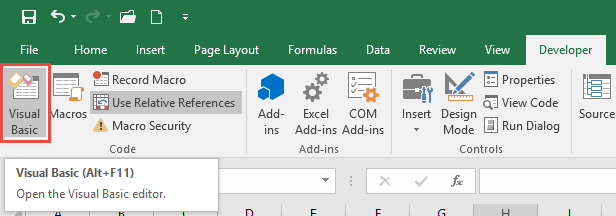

OnTime Events: OnTime events are those which can trigger code on a particular point of time.Userform Events: These events are associated with the action happen with a user form.Chart Events: These events are associated with the chart sheets (which are different from worksheets).Worksheet Events: These events are associated with the action happens in a worksheet.Workbook Events: These are events that are associated with the actions that happen in a workbook.Application Events: These are events that are associated with Excel application itself.Below is the classification of events based on the objects: Whenever you do something in Excel, that’s an event: enter a value in a cell, insert a new worksheet, or insert a chart. The workbook you use in Excel has different objects, and with all those objects, there are several properties that you can access and methods that you can use. Visual Basic for Applications is an Object-Oriented language, and to make the best out of it you need to understand Excel Objects. If you omit the data type, VBA applies the Variant data type to your variable (it’s the most flexible), VBA won’t guess what the data type should be. When you specify the data type for a variable or a constant, it ensures the validity of your data. In the above code, again boxes are the collection, and Unlock is the property that is set to TRUE. Here’s another way: Box(“Red”).Unlock = True If you have multiple boxes we are defining a specific box here. In the above code, boxes are the collection, and open is the method. And for this the code will be: Boxes(“Red”).Open Let’s go a bit specific, let say if you want to open the box which is RED in color. It’s plain English, Right? But when it comes to VBA and writing a macro this will be: Box.OpenĪs you can see, the above code is started with the box which is our object here, and then we have used the method “Open” for it. The words you will use would be “Open the Box”. There are objects, collections, methods, and properties which you can use in VBA to write your code.ĭon’t miss this: Let’s say you want to tell someone to open a box. In simple words, first, we define the object and then the activity which we want to perform. This will help you create data-driven, fully-functional applications.VBA is an Object-Oriented Language and as an object-oriented language, in VBA, we structure our codes in a way where we are using objects and then defining their properties. Programs can be created and corrected by dragging and dropping data from your primary database to Visual Basic. These should be used together with its syntax checking and IntelliSense intuitive development functionality to automatically find errors and create suggestions.
#Learn visual basic for excel free windows#
It supports a variety of Windows themes, enabling you to create applications that are in-line with Windows operating systems. The program also inputs XAML code for you so you can immediately launch programs with the Publish button.

It is integrated with F#, MFC, and C++ functionality, Windows Presentation Framework, and multi-targeting support. Microsoft Visual Basic can be used to develop Silverlight applications, metro-style programs, desktop software, and hardware drivers. These editing tools are easy to use as it can adjust elements of programming modules automatically, making it a suitable program for new developers and hobbyists. Its features are displayed on a plain and organized interface where you can easily access its progress bar, labels, and buttons. All files stored in the program can be exported as an executable file. Microsoft Visual Basic is used to develop and compile Windows applications.


 0 kommentar(er)
0 kommentar(er)
